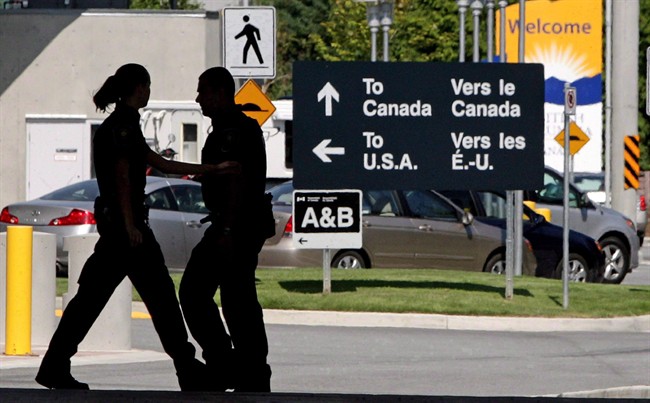TORONTO – The governments of Canada and the United States have an agreement regarding how refugee claimants are handled along the two nations’ shared land border.

According to the Canadian government, a “safe third country” is a country (other than Canada and the “country of alleged persecution”) where a person can make a claim for refugee protection. The U.S. is the only country Canada has so designated.
Under the agreement, which came into effect in 2004, individuals seeking protection must make a claim in the first country they arrive in (either Canada or the U.S.), unless they qualify for an exception.
So, a refugee that first arrives in the U.S. must submit a claim for protection in the U.S., and those who arrive in Canada must apply for protection in Canada.
READ MORE: Refugees risking their lives to find sanctuary in Canada
The agreement applies to refugee claimants seeking entry to Canada from the U.S. at land border crossings, by train and by air. However, according to the Canadian government, the agreement only applies at airports if the individual seeking refugee protection in Canada has been “determined not to be a refugee in the United States, has been ordered deported from the United States and is in transit through Canada for removal from the United States.”
There are four types of exceptions to the agreement, which take into effect whether the individual has family in Canada, is an unaccompanied minor, has a specific valid document such as a Canadian visa or work permit. There is also a “public interest exception” to the agreement which assesses whether the claimant could be subject to the death penalty for an offence they’ve been charged with or convicted of.
The “safe third country” agreement is not without criticism. The Canadian Council for Refugees said the legislation effectively closes the door on the majority of refugee claimants at the Canada-U.S. border.
- Honda expected to announce Ontario EV battery plant, part of a $15B investment
- Trudeau says ‘good luck’ to Saskatchewan premier in carbon price spat
- Canadians more likely to eat food past best-before date. What are the risks?
- Hundreds mourn 16-year-old Halifax homicide victim: ‘The youth are feeling it’
“The Canadian Council for Refugees (CCR) strenuously opposes the Agreement, because the U.S. is not a safe country for all refugees,” reads a statement on the CCR’s website. “The CCR also denounces the purpose and effect of reducing the number of refugees who can seek Canada’s protection.”
The CCR believes that the agreement “is about preventing people who are in the U.S., or travelling through the U.S., from making a refugee claim in Canada.”
In 2006, the CCR made a submission to the federal Cabinet, urging Cabinet to withdraw the designation of the U.S. as a safe third country, arguing that the U.S. is not a safe place for refugees. The CCR argued that the U.S. routinely holds asylum seekers in detention, where they have little hope of being granted refugee protection, often denies protection to those who face persecution, and has policies that discriminate against refugees.
The Canadian government insists the agreement does not shut the door to all refugees at the U.S. border, saying “if you meet one of the exceptions to the safe third country rule, you will be able to present your refugee claim in Canada.”
“The objectives of the agreement are to enhance the orderly handling of refugee claims, and to act as a disincentive to asylum seekers making claims in both countries, or travelling through one country to make their claim in the country that the claimants perceive as more favourable to their claim,” read a statement from Citizenship and Immigration Canada to Global News.
The agreement has been challenged in the courts and in 2007 was deemed unconstitutional by the Federal Court of Canada. However in 2008, the Federal Court of Appeal said the agreement was constitutional. In 2009, Canada’s top court said the decision was final and would not review the agreement.


Comments